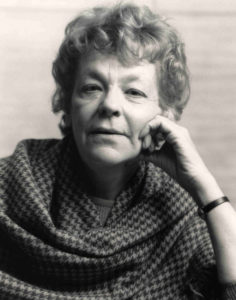
In 1994, 61 people contributed $44,000 to a charitable remainder trust, administered by the Ontario Arts Foundation to create an income for Mary Jolliffe (1923-2014) one of Canada’s best known publicists.
Mary was a character, who like many artists, devoted her life to supporting the arts in North America. Her first role as a publicist was with the Stratford Festival at its beginning in 1953. From there, there were few significant public relations roles that Mary did not hold – O’Keefe Centre in Toronto, the Guthrie Theatre in Minneapolis, the Metropolitan Opera touring company in New York, Expo 67 in Montreal, the National Ballet of Canada, National Arts Centre, the Canada Council and the Ontario Arts Council. Her passion and commitment to promoting artists and arts organizations was lifelong and she left her mark at every organization. Mary was recognized for her efforts by being named to the Order of Canada in 1985.
Like many artists, Mary moved from role to role and devoted most of her resources during her working life to her lifestyle and the organizations she supported. When retirement became a reality, she found herself with limited sources of income. As a way to recognize her many accomplishments, the individuals contributing to the trust wanted to provide an income supplement to help cover Mary’s costs of living. The OAF successfully managed the Mary Jolliffe Fund for 20 years. Quarterly annual income payments were made Mary totaling over $80,000. At her death, the fund was valued $46,000.
Charitable Remainder Trusts
Charitable remainder trusts (“CRT’s) are a tax planned way to create a fund to provide an annual income for life to a named beneficiary. On the death of the beneficiary, the remaining capital is transferred to a registered charity. There are several advantages, to this form of trust, which is not often used by Canadians as part of long-term tax and estate planning.
- A charitable remainder trust may be funded with cash, securities or real estate. The contributions are held by a trustee ( such as the OAF )
- The named beneficiary is entitled to receive the income for life ( in effect a form of annuity ).
- Gifts to the trust are irrevocable and the beneficiary has no right to any of the capital contributed
- On the death of the life beneficiary, the remaining capital is transferred to a charitable organization named in the trust agreement.
- As the gifts to the trust are irrevocable, the donor(s) receive a charitable donation tax receipt. The amount of the receipt is based on the present value of the remainder interest, which is determined by the value of the assets contributed, prevailing interest rates and the life expectancy of the income beneficiary.
Some individuals create a trust as a means of ensuring a future gift to a charity important to them, while continuing to receive income from the property which is removed from their estate. The value is not subject to probate fees at the time of the death of the income beneficiary. The trust is responsibly managed by the Trustee, who will provide the annual income.
Mary Jolliffe Award for Arts Administrators
The capital remaining in the Mary Jolliffe Fund will now be used to fund an award, recognizing the contribution of senior arts administrators in Canada to the arts. In this way, the legacy of the lifelong commitment of Mary Jolliffe to the arts will be continued by honouring people like her, who are similarly accomplished. For arts philanthropists, a CRT offers another way to support the work and life accomplishments of an artist in a way that helps the individual, is tax effective to the donor and provides a future gift to a charitable organization.
